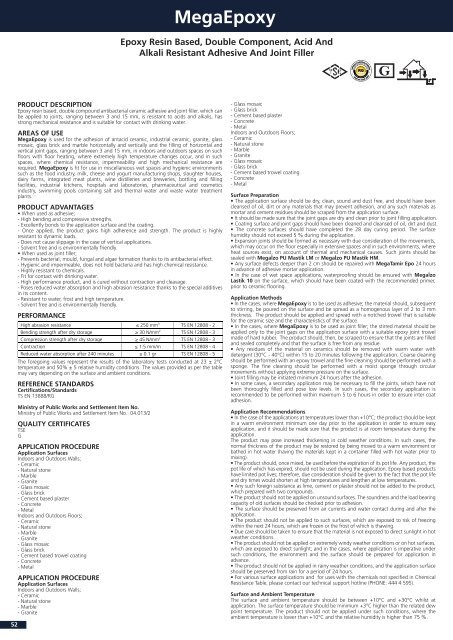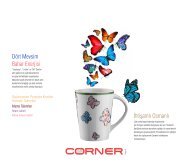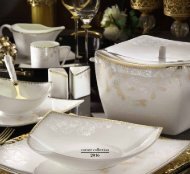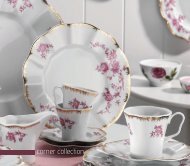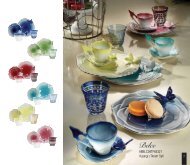You also want an ePaper? Increase the reach of your titles
YUMPU automatically turns print PDFs into web optimized ePapers that Google loves.
MegaEpoxy<br />
Epoxy Resin Based, Double Component, Acid And<br />
Alkali Resistant Adhesive And Joint Filler<br />
G<br />
52<br />
PRODUCT DESCRIPTION<br />
Epoxy resin based, double compound antibacterial ceramic adhesive and joint filler, which can<br />
be applied to joints, ranging between 3 and 15 mm, is resistant to acids and alkalis, has<br />
strong mechanical resistance and is suitable for contact with drinking water.<br />
AREAS OF USE<br />
MegaEpoxy is used for the adhesion of antacid ceramic, industrial ceramic, granite, glass<br />
mosaic, glass brick and marble horizontally and vertically and the filling of horizontal and<br />
vertical joint gaps, ranging between 3 and 15 mm, in indoors and outdoors spaces on such<br />
floors with floor heating, where extremely high temperature changes occur, and in such<br />
spaces, where chemical resistance, impermeability and high mechanical resistance are<br />
required. MegaEpoxy is fit for use in miscellaneous wet spaces and hygienic environments<br />
such as the food industry, milk, cheese and yogurt manufacturing shops, slaughter houses,<br />
dairy farms, integrated meat plants, wine distilleries and breweries, bottling and filling<br />
facilities, industrial kitchens, hospitals and laboratories, pharmaceutical and cosmetics<br />
industry, swimming pools containing salt and thermal water and waste water treatment<br />
plants.<br />
PRODUCT ADVANTAGES<br />
• When used as adhesive;<br />
- High bending and compressive strengths.<br />
- Excellently bonds to the application surface and the coating.<br />
- Once applied, the product gains high adherence and strength. The product is highly<br />
resistant to dynamic loads.<br />
- Does not cause slippage in the case of vertical applications.<br />
- Solvent free and is environmentally friendly.<br />
• When used as joint filler;<br />
- Prevents bacterial, mould, fungal and algae formation thanks to its antibacterial effect.<br />
- Hygienic and impermeable, does not hold bacteria and has high chemical resistance.<br />
- Highly resistant to <strong>chemicals</strong>.<br />
- Fit for contact with drinking water.<br />
- High performance product, and is cured without contraction and cleavage.<br />
- Poses reduced water absorption and high abrasion resistance thanks to the special additives<br />
in its content.<br />
- Resistant to water, frost and high temperature.<br />
- Solvent free and is environmentally friendly.<br />
PERFORMANCE<br />
High abrasion resistance ≤ 250 mm 3 TS EN 12808 - 2<br />
Bending strength after dry storage ≥ 30 N/mm 2 TS EN 12808 - 3<br />
Compression strength after dry storage ≥ 45 N/mm 2 TS EN 12808 - 3<br />
Contraction ≤ 1.5 mm/m TS EN 12808 - 4<br />
Reduced water absorption after 240 minutes ≤ 0.1 gr TS EN 12808 - 5<br />
The foregoing values represent the results of the laboratory tests conducted at 23 ± 2°C<br />
temperature and 50% ± 5 relative humidity conditions. The values provided as per the table<br />
may vary depending on the surface and ambient conditions.<br />
REFERENCE STANDARDS<br />
Certifications/Standards<br />
TS EN 13888/RG<br />
Ministry of Public Works and Settlement Item No.<br />
Ministry of Public Works and Settlement Item No.: 04.013/2<br />
QUALITY CERTIFICATES<br />
TSE<br />
G<br />
APPLICATION PROCEDURE<br />
Application Surfaces<br />
Indoors and Outdoors Walls;<br />
- Ceramic<br />
- Natural stone<br />
- Marble<br />
- Granite<br />
- Glass mosaic<br />
- Glass brick<br />
- Cement based plaster<br />
- Concrete<br />
- Metal<br />
Indoors and Outdoors Floors;<br />
- Ceramic<br />
- Natural stone<br />
- Marble<br />
- Granite<br />
- Glass mosaic<br />
- Glass brick<br />
- Cement based trowel coating<br />
- Concrete<br />
- Metal<br />
APPLICATION PROCEDURE<br />
Application Surfaces<br />
Indoors and Outdoors Walls;<br />
- Ceramic<br />
- Natural stone<br />
- Marble<br />
- Granite<br />
- Glass mosaic<br />
- Glass brick<br />
- Cement based plaster<br />
- Concrete<br />
- Metal<br />
Indoors and Outdoors Floors;<br />
- Ceramic<br />
- Natural stone<br />
- Marble<br />
- Granite<br />
- Glass mosaic<br />
- Glass brick<br />
- Cement based trowel coating<br />
- Concrete<br />
- Metal<br />
Surface Preparation<br />
• The application surface should be dry, clean, sound and dust free, and should have been<br />
cleansed of oil, dirt or any materials that may prevent adhesion, and any such materials as<br />
mortar and cement residues should be scraped from the application surface.<br />
• It should be made sure that the joint gaps are dry and clean prior to joint filling application.<br />
• Coating surface and joint gaps should have been cleaned and cleansed of oil, dirt and dust.<br />
• The concrete surfaces should have completed the 28 day curing period. The surface<br />
humidity should not exceed 5 % during the application.<br />
• Expansion joints should be formed as necessary with due consideration of the movements,<br />
which may occur on the floor especially in extensive spaces and in such environments, where<br />
heat sources exist, on account of thermal and mechanical causes. Such joints should be<br />
sealed with Megaİzo PU Mastik LM or Megaİzo PU Mastik HM.<br />
• Any surface defects deeper than 2 cm should be repaired with MegaTamir Epo 24 hours<br />
in advance of adhesive mortar application.<br />
• In the case of wet space applications, waterproofing should be ensured with Megaİzo<br />
Lastik 10 on the surface, which should have been coated with the recommended primer,<br />
prior to ceramic flooring.<br />
Application Methods<br />
• In the cases, where MegaEpoxy is to be used as adhesive; the material should, subsequent<br />
to stirring, be poured on the surface and be spread as a homogenous layer of 2 to 3 mm<br />
thickness. The product should be applied and spread with a notched trowel that is suitable<br />
for the ceramic size and the characteristics of the surface.<br />
• In the cases, where MegaEpoxy is to be used as joint filler; the stirred material should be<br />
applied only to the joint gaps on the application surface with a suitable epoxy joint trowel<br />
made of hard rubber. The product should, then, be scraped to ensure that the joints are filled<br />
and sealed completely and that the surface is free from any residue.<br />
• Any residues of the material on ceramics should be removed with warm water with<br />
detergent (30°C - 40°C) within 15 to 20 minutes following the application. Coarse cleaning<br />
should be performed with an epoxy trowel and the fine cleaning should be performed with a<br />
sponge. The fine cleaning should be performed with a moist sponge through circular<br />
movements without applying extreme pressure on the surface.<br />
• Joint filling may be initiated minimum 24 hours after the adhesion.<br />
• In some cases, a secondary application may be necessary to fill the joints, which have not<br />
been thoroughly filled and pose low levels. In such cases, the secondary application is<br />
recommended to be performed within maximum 5 to 6 hours in order to ensure inter coat<br />
adhesion.<br />
Application Recommendations<br />
• In the case of the applications at temperatures lower than +10°C; the product should be kept<br />
in a warm environment minimum one day prior to the application in order to ensure easy<br />
application, and it should be made sure that the product is at room temperature during the<br />
application.<br />
The product may pose increased thickening in cold weather conditions. In such cases, the<br />
normal thickness of the product may be restored by being moved to a warm environment or<br />
bathed in hot water (having the materials kept in a container filled with hot water prior to<br />
mixing).<br />
• The product should, once mixed, be used before the expiration of its pot life. Any product, the<br />
pot life of which has expired, should not be used during the application. Epoxy based products<br />
have limited pot lives; therefore, due consideration should be given to the fact that the pot life<br />
and dry times would shorten at high temperatures and lengthen at low temperatures.<br />
• Any such foreign substance as lime, cement or plaster should not be added to the product,<br />
which prepared with two compounds.<br />
• The product should not be applied on unsound surfaces. The soundness and the load bearing<br />
capacity of old surfaces should be checked prior to adhesion.<br />
• The surface should be preserved from air currents and water contact during and after the<br />
application.<br />
• The product should not be applied to such surfaces, which are exposed to risk of freezing<br />
within the next 24 hours, which are frozen or the frost of which is thawing.<br />
• Due care should be taken to ensure that the material is not exposed to direct sunlight in hot<br />
weather conditions.<br />
• The product should not be applied on extremely windy weather conditions or on hot surfaces,<br />
which are exposed to direct sunlight; and in the cases, where application is imperative under<br />
such conditions, the environment and the surface should be prepared for application in<br />
advance.<br />
• The product should not be applied in rainy weather conditions, and the application surface<br />
should be preserved from rain for a period of 24 hours.<br />
• For various surface applications and for uses with the <strong>chemicals</strong> not specified in Chemical<br />
Resistance Table, please contact our technical support hotline (PHONE: 444 4 595).<br />
Surface and Ambient Temperature<br />
The surface and ambient temperature should be between +10°C and +30°C whilst at<br />
application. The surface temperature should be minimum +3°C higher than the related dew<br />
point temperature. The product should not be applied under such conditions, where the<br />
ambient temperature is lower than +10°C and the relative humidity is higher than 75 %.


